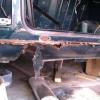Just curious. As I have a possible developing issue in the cam follower area, and I have a 1275, it doesn't have these covers. It occurs to me that it would have been much easier to have a poke around and see what was what if it did, and it made me wonder why they were designed out of the block? Is there a good reason for it?

Why Did Rover / Austin Etc Do Away With Tappet Chest Covers?
#1

Posted 30 July 2015 - 10:04 AM
#2

Posted 30 July 2015 - 10:23 AM
Best guess would be less places to leak oil
#3

Posted 30 July 2015 - 10:24 AM
I have to say, I'm glad they don't have tappet covers and IMO, all the A Series engines would have benefited from that design. I'm fairly sure that when the 1275 Non-Cooper S Engine was developed they went for a solid tappet cover to reduce noise and also take some of the harshness out of it, it was after all designed with the Austin / Morris 1300 Series in mind (initially), which were offered in a bit of a step up in the Market from the Mini. Curiously, when BL (wasted - did I say that!) spent the 30 million quid on the A+ Engine development, they still retained the tappet covers on the small bore blocks, though they did drop those blocks all together in later years.
I know this doesn't help you though, but none the less,if it were me and an engine started developing a tappet problem, I don't think I'd be changing the tappets without looking at the camshaft as well.
Edited by Moke Spider, 30 July 2015 - 10:25 AM.
#4

Posted 30 July 2015 - 10:31 AM
pity they can't be got at from the head gasket area , then no need for tappet chest
#5

Posted 30 July 2015 - 10:33 AM
Just curious. As I have a possible developing issue in the cam follower area, and I have a 1275, it doesn't have these covers. It occurs to me that it would have been much easier to have a poke around and see what was what if it did, and it made me wonder why they were designed out of the block? Is there a good reason for it?
but what would you be looking at. the only gain is you can pull the followers out.
if after looking at the push rods and rockers you see nothing amiss then it is engine out time really.
#6

Posted 30 July 2015 - 11:23 AM
There's more metal in solid walled block, so one could infer that they are stronger...
I suspect the 998 was only phased out for one reason, emissions.
#7

Posted 30 July 2015 - 11:45 AM
It is on record that an 850cc A-series engine cost more to produce in the later years than a 998cc because of the lower volumes in production.....even though the 850 Mini had to be sold for less it cost more to build. I suspect the same thing happened with the later 998cc.....as the Metro stopped using the 998cc A-series and the 1990's Rover Coopers sold greater numbers of the 1275cc, so the 998cc volumes became uneconomic to produce along with meeting emissions testing as mentioned. Large production volumes are key to lower costs in the car industry, even more so today as manufacturers strive to share common platforms and engines.
eg. The modern Mk1 and Mk2 BMW MINI was expensive to build on a unique platform originally designed by Rover in the late 1990's, therefore with the latest F56 Mk3 MINI, BMW have moved to a platform which will be shared with other small and medium size fwd BMW's in order to share lower costs and increase production volumes.
Edited by mab01uk, 30 July 2015 - 11:53 AM.
#8

Posted 30 July 2015 - 11:55 AM
#9

Posted 30 July 2015 - 12:23 PM
Looks like the value engineers were at work
#10

Posted 30 July 2015 - 12:42 PM
Working in a mechanical and production engineering background I would guess it was as already mentioned for additional strength,
dont you mean cheaper materials for the same strength.
#11

Posted 30 July 2015 - 06:27 PM
Partly cost:
Tappet covers requires: 2 x tappet covers, 2 x bolts, 2 x cup washers, 2 x washers, 2 x gaskets plus that area of the block has to be machined
Partly strength:
Early 1275 blocks do flex hence the gradual beefing up of the inside centre web area and bottom flanges. The works Cooper Car Co racers used the solid rear wall blocks rather than S blocks.
#12

Posted 30 July 2015 - 07:37 PM
Might also be related to when they went out.
There'd have been no inline small bore engines, and tappet chests are of less benefit if you can easily drop the sump pan. Rationalise 1275 production across Marinas, Allegros etc. Keep tappet chests on engine exclusively for the transverse Mini and, I think, the odd 1098 Allegro offered to the extreme motoring masochists. It doesn't explain why 30 million on the A+ couldn't standardise for the then only transverse A. (Actually, there were some 1.3 Itals, but they were end of life makeovers that even Austin Rover wouldn't have wasted R&D money on.)
The last Minis were struggling to meet noise regulations and compete with more refined "fun" cars like the 1.3 SR Nova. The 1275 offered a bit more oomph and without the as much need to thrash it like the 998.
1 user(s) are reading this topic
0 members, 1 guests, 0 anonymous users





















